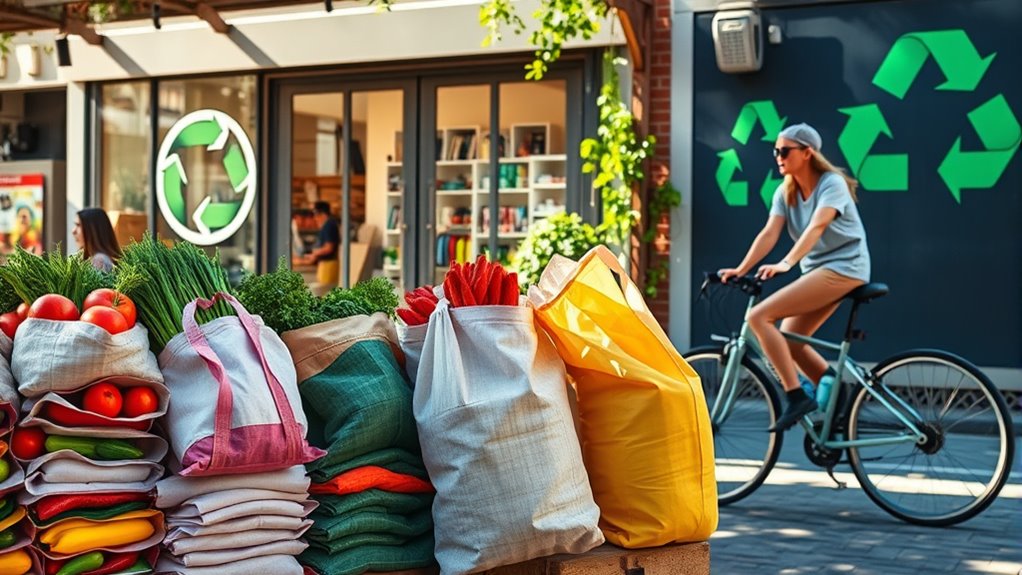The circular economy encourages you to rethink how you use resources by emphasizing reuse, recycling, and designing products for longevity. Instead of toss-away culture, focus on items that can be repaired, refurbished, or recycled to reduce waste and environmental impact. Your choices—like supporting brands with sustainable practices or properly recycling—shape a more eco-friendly system. Keeping informed can help you make smarter decisions, and ongoing knowledge will reveal how your actions really make a difference.
Key Takeaways
- The circular economy shifts from wasteful linear models to sustainable resource use through recycling, reuse, and design.
- Consumers can support sustainability by choosing durable, repairable products and participating in recycling and take-back programs.
- Making eco-friendly choices reduces environmental impact and encourages companies to adopt sustainable practices.
- Consumer demand influences companies to innovate and implement circular principles in product design and production.
- Educating oneself and advocating for responsible consumption helps promote policies and practices aligned with the circular economy.

Have you ever wondered how your everyday choices can contribute to a more sustainable world? When you make conscious decisions about the products you buy and use, you’re participating in a movement towards a circular economy—an approach that seeks to minimize waste and maximize resource use. One way to do this is by understanding sustainable practices, which focus on designing, producing, and consuming products with their entire lifecycle in mind. By considering the product lifecycle, you can play a vital role in reducing environmental impact, encouraging companies to adopt eco-friendly methods, and supporting a system that values reuse and recycling over disposal.
In a circular economy, the emphasis shifts from the traditional linear model—take, make, dispose—to a more holistic view that extends the life of products. This means you should look for items designed with durability, repairability, and recyclability in mind. When purchasing, prioritize products with transparent information about their product lifecycle, including how they’re made, how long they’ll last, and what happens to them when they’re no longer useful. Your choices can push companies to adopt sustainable practices that reduce resource extraction, lower emissions, and decrease waste. For example, choosing products made from recycled materials or supporting brands committed to circular principles encourages manufacturers to innovate and improve their product designs.
Furthermore, embracing sustainable practices as a consumer isn’t limited to just choosing eco-friendly products. It also involves how you care for and dispose of them. Proper maintenance can extend a product’s lifespan, delaying the need for replacements and reducing waste. When a product reaches the end of its life, look for options like recycling or refurbishing, which help keep materials circulating within the economy rather than ending up in landfills. Participating in take-back programs or supporting local repair shops can also make a difference, ensuring that valuable materials aren’t wasted and can be repurposed into new products.
Your influence extends beyond individual purchases. By advocating for companies to adopt sustainable practices, supporting policies that promote circular economy principles, and spreading awareness, you help create a demand for more responsible production and consumption. The more you educate yourself about the product lifecycle and the impact of your choices, the more empowered you’ll be to support a system that benefits the environment and society. Every small decision adds up in the collective effort to shift to a circular economy—one where resources are valued, waste is minimized, and sustainability becomes the standard, not the exception.
Frequently Asked Questions
How Can I Identify Products Made From Circular Economy Practices?
To identify products made from circular economy practices, look for labels or certifications indicating the use of sustainable materials and eco-friendly manufacturing. Check product packaging or descriptions for information about the product lifecycle, such as recyclability, reusability, or durability. Brands committed to circular practices often highlight these features. By paying attention to these indicators, you can make more informed choices that support sustainability and reduce waste.
What Certifications Indicate a Product Follows Circular Economy Principles?
Think of certifications as your compass in the vast sea of products. Look for labels like Cradle to Cradle, B Corp, or FSC, which signal adherence to sustainability standards and circular economy principles. These certifications act as a lighthouse, guiding you toward eco-conscious choices. When product labeling bears these marks, you’re supporting companies committed to rethinking resource use, closing loops, and fostering a sustainable future.
How Does the Circular Economy Impact Product Pricing?
You might notice that circular economy principles influence product pricing strategies, often leading to higher upfront costs due to eco-friendly materials or refurbishing processes. However, these strategies aim to balance consumer affordability over time by promoting durability and reuse. While prices can initially be higher, you benefit from longer-lasting products and reduced waste, making sustainable choices more accessible and cost-effective in the long run.
Can I Participate in the Circular Economy Without Buying New Products?
You can definitely participate in the circular economy without buying new products. Focus on improving your recycling habits by properly sorting waste and reusing items whenever possible. Additionally, use sharing platforms to borrow or rent goods instead of purchasing new ones. These actions reduce waste, extend product life cycles, and support a sustainable system. Your involvement makes a difference, and it’s easier than you might think to contribute to a circular economy.
What Are Common Challenges Consumers Face With Circular Economy Initiatives?
You might face challenges like recycling misconceptions, which cause confusion about what’s recyclable and how to recycle properly. Limited product availability can also be a hurdle, making it hard to find circular economy-friendly options. These issues can discourage your participation, but staying informed and supporting brands committed to sustainability can help overcome these obstacles. Embracing small steps and educating yourself makes it easier to contribute effectively.
Conclusion
By embracing the circular economy, you help reduce waste and conserve resources. Did you know that extending product lifespans and recycling can cut global carbon emissions by up to 39%? Every choice to repair, reuse, or recycle makes a difference. So, stay informed and make mindful decisions—your actions contribute to a healthier planet. Together, we can create a sustainable future where resources are valued and waste is minimized.









